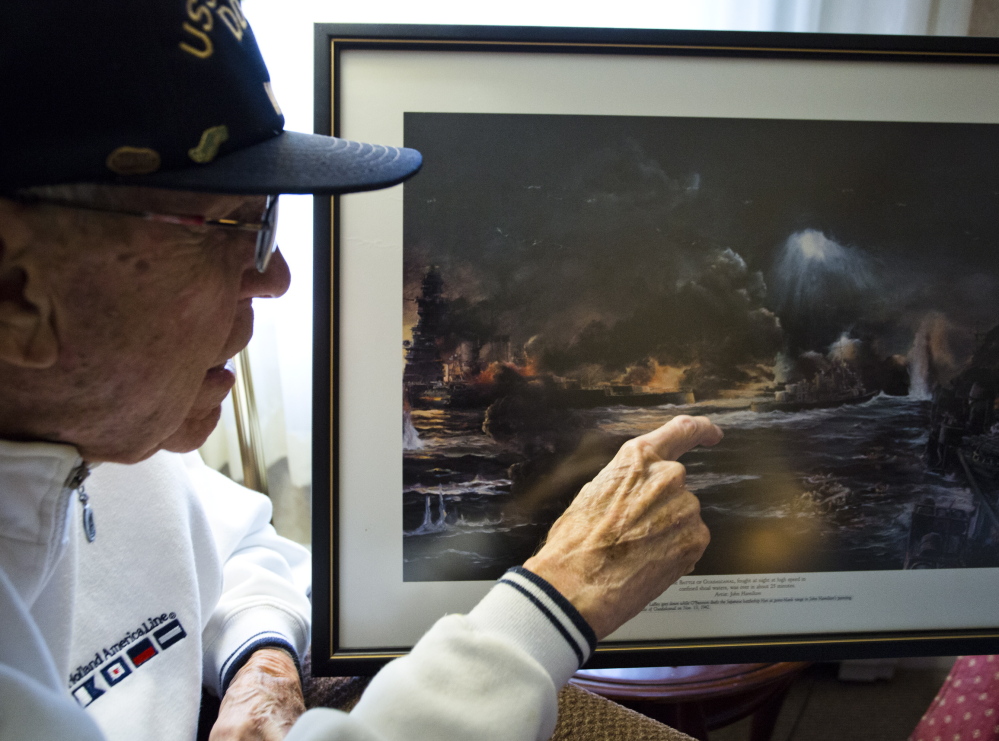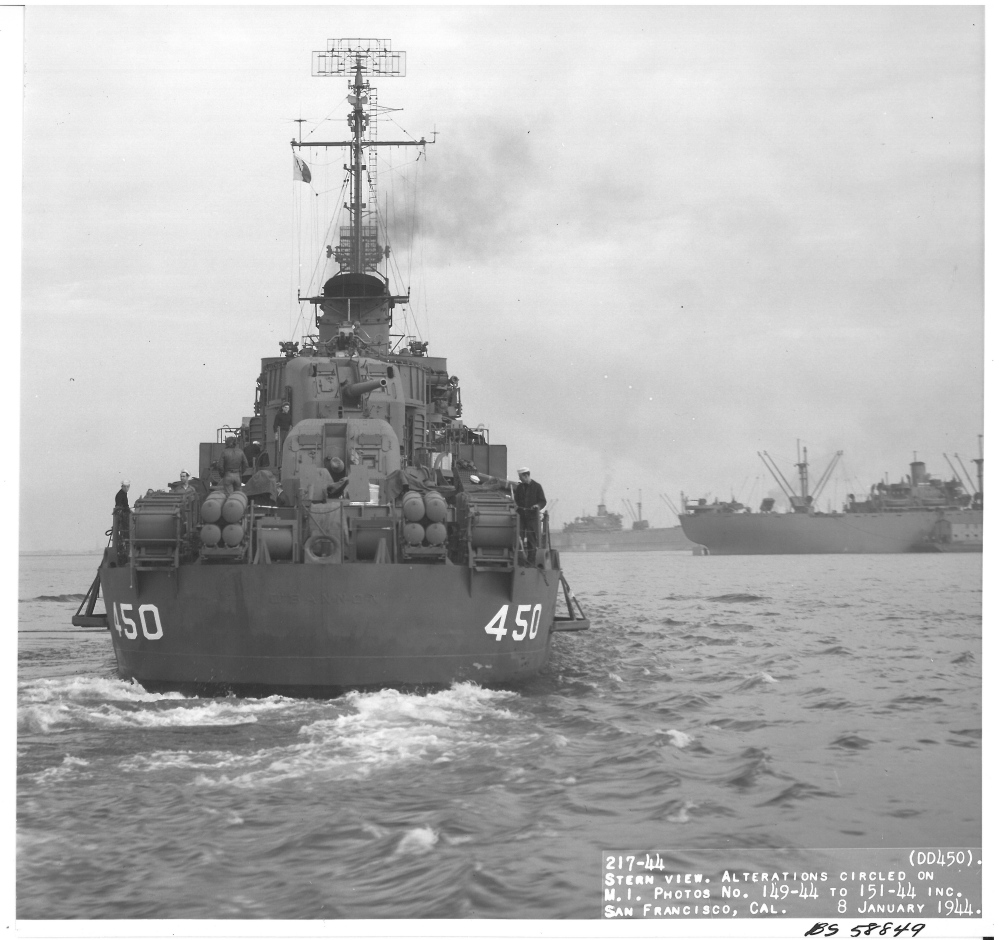It was just after 1:30 a.m. on the morning of Nov. 13, 1942, when Lendall Knight and his shipmates aboard the USS O’Bannon found themselves under the guns of a massive Japanese battleship.
It was David versus Goliath. The O’Bannon, a Maine-made destroyer from Bath Iron Works with a crew of 275, was dwarfed by the Hiei, the Japanese admiral’s flagship. The O’Bannon’s 5-inch-diameter guns were no match for the Japanese battleship’s 14-inch guns.
However, the smaller and more maneuverable O’Bannon was able to get close to the Hiei and rake it with fire – so close, in fact, the Hiei couldn’t shift its cannons low enough to hit the O’Bannon. Its massive shells screamed harmlessly overhead.
“We were then 400 yards from the Japanese ship,” Knight, a 95-year-old Cumberland resident, remembered on the 72nd anniversary of what is known as the Naval Battle of Guadalcanal. “The executive officer, I could hear his commands: ‘Emergency back! Emergency full!’ to keep from running into and colliding with other ships.”
Knight relived the battle from his recliner at the Ledgeview Assisted Living facility Thursday. One of about 20 living veterans who served on the destroyer in World War II, he wore a USS O’Bannon baseball cap and showed off a painting depicting the O’Bannon’s showdown with the Hiei that hangs on a wall in his room.
The encounter, in what would become known as Iron Bottom Bay because of the number of ships that sank there, turned into a fierce nighttime brawl at close quarters with destroyers, cruisers and battleships firing broadsides at point-blank range. It was the first victory U.S. naval forces had against the Japanese in the battle for control of the South Pacific during World War II.
Knight, then a 23-year-old lieutenant, spent the battle inside one of the O’Bannon’s gun turrets.
“Every time the gun fired, the turret door would blow open and I could see star shells, ships blowing up and it became a melee,” Knight said. “I could hear the gunnery officer exclaiming that this was murder, his spraying the Japanese pagoda” – the Hiei’s superstructure – “up and down until it turned cherry red.”
The Hiei sank later that day.
The O’Bannon’s role in the battle was significant, according to James Hornfischer, a military historian and author of “Neptune’s Inferno,” which chronicles the Naval Battle of Guadalcanal.
“When the supreme moment came, the O’Bannon led the way, attacking a ship 12 times her size at point-blank range, damaging her and disordering her commander’s ability to fight,” Hornfischer wrote in an email Friday.
Being fought at night added to the battle’s chaos, as did the American task force losing its commander. Guadalcanal holds the dubious distinction of being the only naval battle of the war in which a U.S. admiral was killed in action, and two admirals died that night – Rear Adm. Daniel Callaghan, the task force’s commander, and Rear Adm. Norman Scott.
The Marines had landed on the island of Guadalcanal two months earlier in the first major amphibious action of the war and captured an airfield the Japanese were building. The Japanese made several attempts to retake the airfield, renamed Henderson Field by the Americans. The Hiei and other Japanese warships sailed into Iron Bottom Bay to bombard the airfield and soften it up for another attack. The O’Bannon and its sister ships were deployed to save the airfield – and they did.
“The Naval Battle of Guadalcanal (aka the Battle of Friday the 13th) ensured a U.S. victory in the first offensive of the war,” Hornfischer wrote. “Admiral Callaghan’s spectacular sacrifice that night saved Henderson Field from a huge Japanese bombardment from the sea. When Guadalcanal’s only airfield was saved, its pilots were able to fly the next morning and sank a whole division of troop transports, drowning their soldiers and ending the threat posed by Japanese forces to Guadalcanal.”
This first phase of the Naval Battle of Guadalcanal lasted less than an hour, but the battle would continue until Nov. 15. The O’Bannon survived almost completely unscathed, but the Navy lost six ships and nearly 1,500 sailors.
“I remember friends who were killed during that battle,” Knight said. “Of course, I feel fortunate that I was spared.”
Knight is one of a shrinking number of veterans who served on the O’Bannon at Guadalcanal. David Heeter, president of the USS O’Bannon Shipmates Association, said a count last year identified 24 living World War II veterans of the ship, which continued to serve in the Navy during the Korean War and the Vietnam War.
“We honored our World War II veterans in San Diego last month,” said Heeter, who served on the O’Bannon during Vietnam. “Only two showed up, so they’re kind of dwindling.”
Knight was born in Boston on April 2, 1919, and grew up in Limerick, where his grandfather had been a cobbler since the Civil War and his father was sheriff of York County from 1939 to 1954. Knight attended Limerick High School and graduated from Bowdoin College in 1941. He signed up to join the Navy while in college and after graduation was sent to Boston to attend intelligence school. It was while he was driving back to Maine with an uncle and aunt that the Japanese bombed Pearl Harbor.
“When we got back to the York County Jail where my father was sheriff, he reported that Pearl Harbor had been bombed and that all naval personnel were to go to their bases,” Knight recalled.
He was transferred to Washington, D.C., but soon decided he wanted to go to sea and asked to be reassigned to a ship that would take him directly into the fight with the Japanese. He asked to serve on a Maine-made ship and was assigned to the O’Bannon, which at that point was still under construction at Bath Iron Works.
The O’Bannon was launched in February 1942 and was commissioned in Boston four months later. It served in numerous convoys before being assigned to the task force that would run into the Hiei and the Japanese task force in the early morning hours of Nov. 13.
The O’Bannon would go on to be the most decorated destroyer of the war, earning 17 battle stars and the distinction of being selected in 1945 by Adm. William “Bull” Halsey to accompany him into Tokyo Harbor to accept the Japanese surrender.
Knight later served on the USS Hall and then as second in command on the USS Haggard. He fought at the battles of the Philippines, Iwo Jima and Okinawa. It was while serving on the Haggard at Okinawa that Knight experienced a kamikaze attack. A Japanese pilot steered his plane, weighed down with bombs, directly into the Haggard’s side. The explosion killed a dozen of Knight’s shipmates, but the ship remained afloat.
Of all his wartime experiences, it’s the Guadalcanal battle that holds a special place in his memories.
“Of course, Veterans Day means a great deal to me and to many people, but the day or two after, Nov. 12 and 13, have more meaning because I was in what is described in history as the greatest naval battle fought between ironclad ships at close range,” Knight said.
Copy the Story LinkSend questions/comments to the editors.




Success. Please wait for the page to reload. If the page does not reload within 5 seconds, please refresh the page.
Enter your email and password to access comments.
Hi, to comment on stories you must . This profile is in addition to your subscription and website login.
Already have a commenting profile? .
Invalid username/password.
Please check your email to confirm and complete your registration.
Only subscribers are eligible to post comments. Please subscribe or login first for digital access. Here’s why.
Use the form below to reset your password. When you've submitted your account email, we will send an email with a reset code.